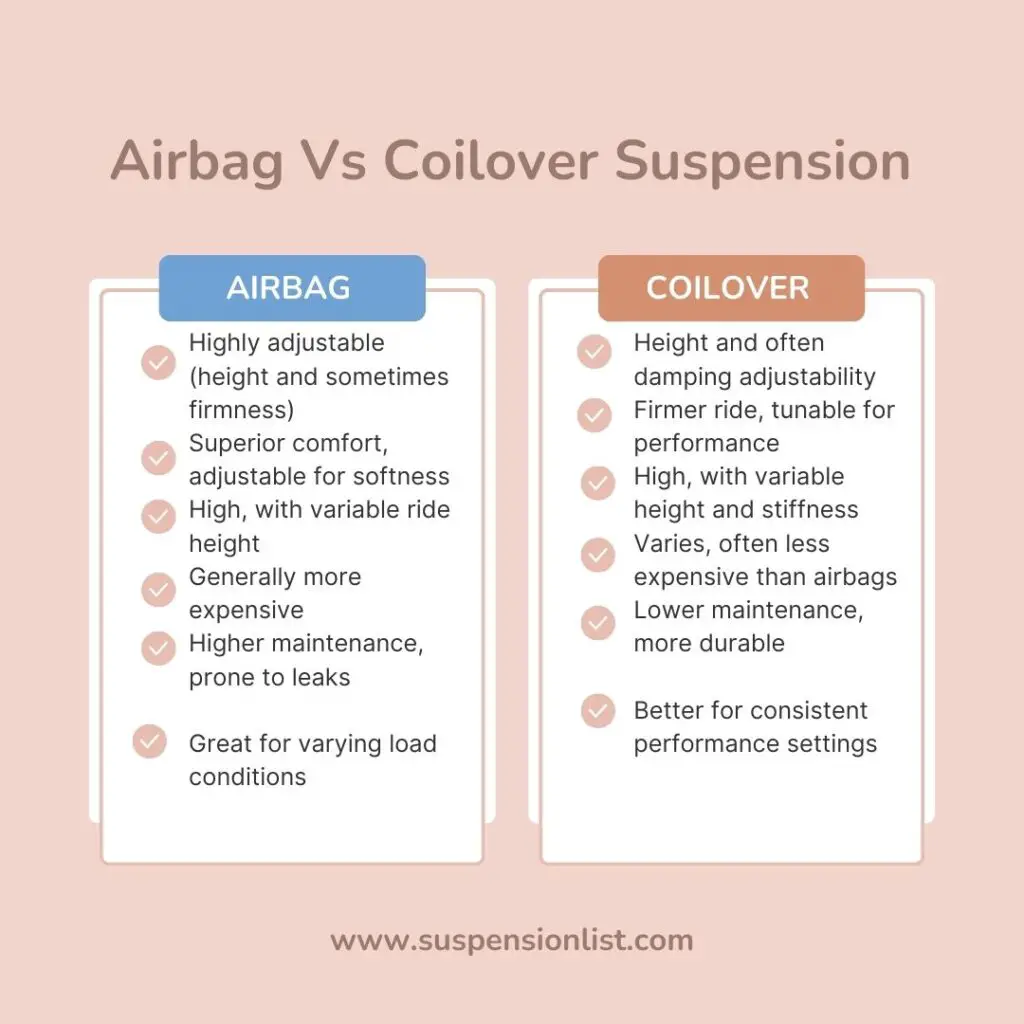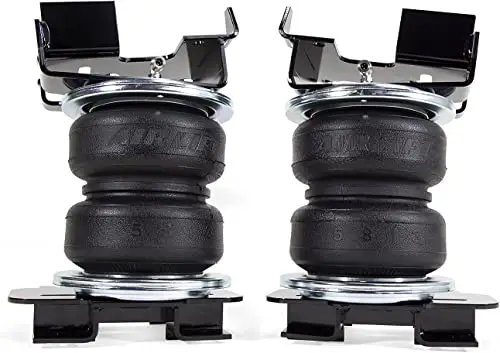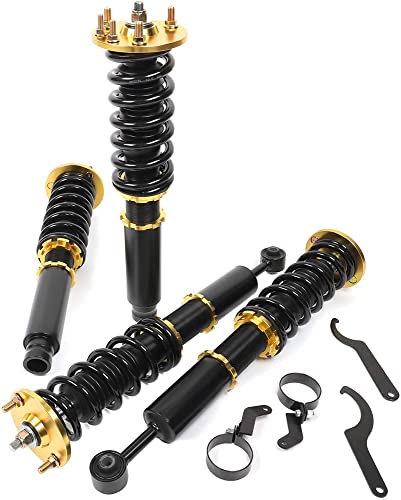Automotive suspension parts as soon as everything is said and done are unique in their complex systems. Over time, the reasons for their nomenclature have become convoluted. For instance, the Airbag vs. coilover debate is more difficult to explain now than it was in simple terms a few years back.
Coilovers and airbags are just two of the most popular suspension upgrades for your vehicle’s comfort and safety. For instance, coilovers and airbags can change the way you drive and handle your car. Choosing between the two can get confusing when you want to take the plunge.
In this scenario, our specialists have already done the research and made the comparison for you thus far. We have examined these two suspension systems in greater detail and in the following paragraphs, we will compare them.
Airbags vs Coilovers In a Table

What is an Airbag?

From the name, you can relate airbags with air balloons because of their working mechanism. Air bags, or air ride suspensions, take the shape of a balloon when installed—also known as an air ride suspension. Air ride suspension is quite similar to your car’s original suspension, allowing it to support its weight.
The air ride suspension is classified as a device configured to compress and store air. A compressor supplies compressed air to an airbag. Because highway-bound trucks typically use air-ride suspension systems, such vehicles are the most common.
Meanwhile, commercial trucks and buses frame their soft rides and responses through compressed-air suspensions. As you progress through the vehicle, relatively more air permits the restraints to be stiffer, while significantly less means a softer experience.
Pros
- The decrease in noise and vibrations results in more comfortable driving conditions, which can go a long way toward lessening fatigue and discomfort of the driver.
- Particularly when the trailer is equipped with air suspension technology, the wheels permit the vehicle to travel longer distances than usual.
- If your steps, struts, and springs are converted to air shocks, the ride quality is drastically improved due to the design of the airbag. Airbags provide a smoother and more enjoyable ride quality that is drastically superior to anything offered by a factory setup.
- The unique main benefit of air suspensions is their ability to rapidly raise or lower your vehicle at the flick of a switch. This is the major reason why most car owners choose to install these systems on their vehicles. This makes installing air suspensions a great decision that will increase your vehicle styling.
Cons
- The greater the air harshness, the lower the expenses of air rides are likely to be. Because you replace all of your vehicle’s suspension components, whether factory or substitute, water intrusion is a risk. Parts are also more prone to malfunction in extreme temperatures.
- Due to the suspension of your vehicle being tied to air to get high enough to turn it on, even one mistake could ideally mean you would no longer be able to drive. It can be worse if you discover that your compressor has busted or has a hole somewhere in the line that raises your vehicle, making it inoperable.
What is A Coilover?

Contemporary auto suspension support is primarily provided with coilovers, and there are many differences to consider when it comes to their mechanism. Officially, a coilover suspension component is a device that prevents the bragging car from surpassing its limits. Coilovers slow down because of the top principle, but the primary difference is that they are connected to a suspension.
You have a camshaft that functions as both the damper and bounce absorber. That mechanism is made simple by a coiled spring that surrounds the axle’s damper, and both these elements work together to absorb the impact from the wheels, especially when your car hits a bump in the road. Depending on the car manufacturer’s spring constant, a stiff or soft ride is to be expected.
Pros
- Fans of custom Coilovers point to the enhanced levels of controlling the car compared to the weigh-down suspension options the automotive producer markets. Installing a custom suspension can enhance the efficiency of the handling scheme in the various controls of the driving procedure.
- Read on the suspensions to find an ideal setting for driving. Car drivers are happy to find that these custom assemblies are modifiable. It’s a nice choice for any low-ride vehicle.
- On the other hand, off-road coilovers work better with an impressively high setting. By being able to adjust these settings, suspension systems like these make driving easier.
- Coilovers can benefit off-road automotive enthusiasts who are reckless. These suspensions diminish the risk of a vehicular collision, provide security personnel in the car with enhanced protection, and have become a mainstream choice among a huge number of significant enthusiasts.
Cons
- Coilovers will offer you a firmer ride. Thus, a stiff ride may not be ideal for a common daily vehicle.
- Secondly, they’re often amongst the most expensive suspension systems available for purchase. Unless you are an avid sports car driver or riding in a vehicle for recreation will be the principal use, the expense together with mild driving can make coilovers a less-than-perfect option for you.
Airbag vs. Coilover – A Detailed Overview
The airbag and the Coilover are types of suspension systems that serve the same purpose, but in reality, they are different in terms of structure and function. One offers more adjustability, while the other is more resistant to wear and tear and offers better precision and better responsiveness. Read on for a brief explanation of the air suspension vs. Coilover systems.
Design and Appearance
Though suspension is a component that remains out of sight, still, appearance still means a lot to some people, especially those who love sophistication in everything. Any time you’re installing airbags, it’s not just about the convenience but also the extremely catastrophic appearance that is sure to draw stares.
Who wouldn’t enjoy a lowered-car style? Airbags will be perfect if you’re a car enthusiast since they’re exceedingly straightforward to use. No one appears more ferocious than when they push down on their suspensions, which most particularly applies to motorhead car fanatics.
Coil-overs differ in that they need to be adjusted to multiple qualities, whereas Coilovers, depending on design, concentrate on simply a single. Coil-overs don’t have adjustable casings, but fixed-height casings are available. There are three styles to pick from, thanks to the assortment of opens all around your car–upper and lower shafts, upper and lower cones, or no cones, and only an upper shaft that you’ll raise and lower.
However, they’re also said to improve the appearance of your vehicle and provide several additional opportunities to adjust the distance between the ground and the back of your car.
Ride Quality
Airbags are proven to be a battlefield weapon in tough riding conditions due to their efficiency in reducing kinetic energy. Air springs behave similarly to airbags, substantially permitting drivers to adjust the bumps’ impact on their journeys. With air suspension, a vehicle’s ride height can be altered anywhere, anytime, with quick access to the chest button.
Additional weight can be added without the need to sink your car or truck or add weight to it for overdriving. In actuality, the greater your car is on raised wheels, the less it is going to sink in the rear, and there will likely be fewer issues with your tires getting worn.
However, even if you go with coilovers on your sports car’s everyday driver, it might not feel as comfortable as one that’s outfitted with air suspensions. They’re often the first line of defense against complex and heavy loads. They’re particularly useful in a wide variety of applications since they can wrap around the suspension system.
Handling
This is the zone that most drivers emphasize. If you’ve gone the extra mile to modify your ride, coilovers are good to go due to their ability to limit body roll. Coilovers are fantastic to help you get roared around a race track or have them hang outside for a carefree day out.
Air ride suspensions are more effective for daily drivers than crash bars. They help keep your vehicle functioning smoothly and provide a comforting ride for the driver.
Performance on Tracks
How your suspension setup performs on tracks can be a great determinant of its efficiency. So, we’re also contrasting this fact. In this segment, Coilovers are often used in motorsports because of their ability to maximize cornering stability. When driving at high speeds, being able to properly pivot and control the cornering provides a race car to the driver 1 thing: exceptional handling.
Racing cars that were used many years ago had airbags, which were leveraged when cornering because of their ability to deliver load without damaging balance and the way the go-karting seats rode.
But for modern drivers, coilovers soon became more and more popular because they were incredibly dependable and responsive and did not require much effort to keep them maintained. Coilover with diversified spring rates automatically adjusts to different circumstances. Their resilience is constant because they can be addressed specifically to handle a given amount of compressive force.
To a lesser extent, some of the most typical reasons why coilovers are good for track days are that they’re more durable than air suspension systems and better on tracks that vary. Coilovers are especially perfect for racetracks as they have harder roads and changing shapes that lead to heat in your suspension system.
In addition to the suspension differences you’re going to find between Coilovers for track and hatchbacks, it is also clear that Coilovers permit you to select several performance attributes of your suspension system. These include sway, adhesion, compression, and the spring itself. All of those factors affect how your automobile handles particular tracks.
More resources:
- 3 Link Suspension Vs 4 Link Suspension (Main Differences)
- Leaf Spring Vs 4 Link – Head To Head Comparison
- Sport Suspension Vs Normal Suspension – How Do They Compare?
- Air Ride vs. Hydraulics (With Pros And Cons)
- MacPherson Strut vs. Coilover – What Is The Difference?
- Coilover vs. Lift Kits Vs Spacer Lifts – A Real Comparison
- Lowering Springs Vs Coilovers (With Table)